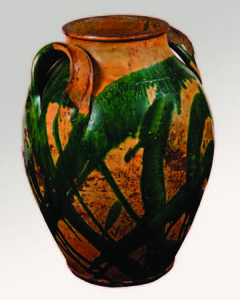

An example of C.A. Haun's work.
It was Dec. 11, almost Christmas, when Christopher Alexander Haun was hanged for his part in burning a bridge in Greene County, Tenn. It was also 1861, and bridge-burning during the Civil War years was punishable by public hanging. That is what happened to Haun and four other men, all Union sympathizers sworn in just before their raid.
The sentence was carried out a month after they were captured for burning the new bridge built across Lick Creek to carry supplies for the Confederate war effort. People in the area were mixed in their sentiments, and although it was a Confederate state, there were those who did not support its cause.
Until almost 20 years ago, however, very few people knew that this Haun, an individual casualty of the Civil War, was the same Haun as the local potter who impressed his name on the crocks and jars he made for a living in Greene County's Pottertown area.
It was two letters written to his wife on the night before he died, but lost for more than a century, that finally unlocked the mystery and linked the two men, one a potter and the other a war activist. Haun worried about his family that last night. His wife, Elizabeth, was just 33 and expecting their fifth child. In his letters he set out instructions to help her ... instructions that obviously referred to a pottery business. He told Elizabeth to have other potters complete his works in progress and then to "sell my shop tools, lead oven, glazing mill, clay mill and lathe."
These, his last letters, were saved, lost and then finally found more than 100 years later, proving that the condemned man and the potter were the same person.
Not only did this sad event deprive a young family of its father and husband, it cut short the career of one of Northeast Tennessee's most gifted potters.
He worked in earthenware and, like other potters, sometimes decorated his vessels, using liquid oxides to add colorful embellishments. Haun, however, went a step further than most. At that time, it was rare for potters to sign their work, but Haun signed some of his. Using a stamp, he impressed a clear " C.A. Haun" near the top and then applied a coggled geometric, almost classical design that encircled the shoulder of his pieces. He carried the art of liquid oxide decoration further than the usual daubs and dribbles seen on most decorated earthenware by instead brushing on his color in a more structured way, forming cross-hatched designs or large swathes of color.
Additionally, he was one of the few potters who used copper oxide to produce green, while most potters used primarily manganese and iron oxides to create blacks and browns. The end results were beautiful, well-formed and distinctively decorative vessels. C.A. Haun's pottery stands out today as a highpoint of the material culture legacy of America's backcountry.
C.A., Haun, Potter is taken from "Backcountry Makers: An Artisan History of Southwest Virginia & Northeast Tennessee." This is the fourth in a series of articles related to this new book by Betsy K. White. Featuring over 200 color images, it is currently in publication by the University of Tennessee Press. "Backcountry Makers" is White's second book on the history of the region's material culture. The first, "Great Road Style: the Decorative Arts Legacy of Southwest Virginia & Northeast Tennessee," was published in 2006 by the University of Virginia Press.